Chong Qing-Cummins engines have small volume. light weight, low fuel consumption, high power and reliable work, and the spare parts supply and maintenance is convenient. The engines adopt electronic governor, with protection functions such as alarm and automatic parking for too high temperature in the cooling water, too low oil pressure or too speed.
This article will guide you to learn the details of CCEC Cummins NTA Series engine’s lubricating system, cooling system and air system. Interested? Then continue reading.
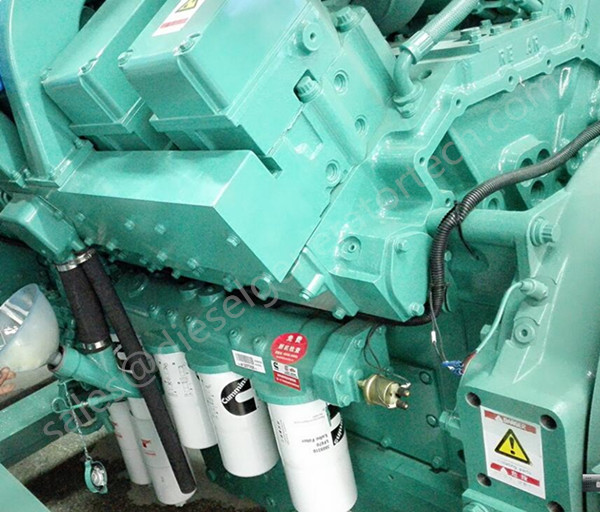
Lubricating System
Chong Qing-Cummins engines are pressure lubricated, pressure is supplied by a gear-type, lubricating oil pump located in oil pan or on side of the engine.
A pressure regulator is mounted in the lubricating oil pump to control lubricating oil pressure.
Filters and screens are provided in lubricating oil system to remove foreign material from circulation and prevent damage to bearings or mating surfaces. A by-pass valve is provided in full-flow oil filter head as insurance against interruption of oil flow by a dirty or clogged element.
Maximum cleansing and filtration is achieved through use of both by-pass and full-flow, lubricating oil filters. Full-flow filters are standard on all engines; by-pass filters are used on all turbocharged models and optionally on all other engines.
Turbochargers are lubricated and cooled by same lubricating oil used for engine lubrication.
Fuel pumps and injectors are lubricated by fuel oil.
N/NT(A) Engines
Oil is drawn into the pump through an external oil line connected to the oil pan sump. A screen in the sump filters the oil. Oil is drawn from the pan by the pump, out through a full-flow or compo filter and circulates back into the block. The filter may be mounted directly to the oil cooler or remote mounted. External lines are used for remote mounting arrangements.
An oil header drilled length of block, fuel pump side, delivers oil to moving parts within the engine.
Oil pipes carry oil from the camshaft to upper rocker housings and drillings through the block, crankshaft, connecting rods, and rocker levers complete the oil circulating passages.
Another oil header drilled the length of the block on exhaust manifold sode, supplies oil to six spray nozzles used for piston cooling.
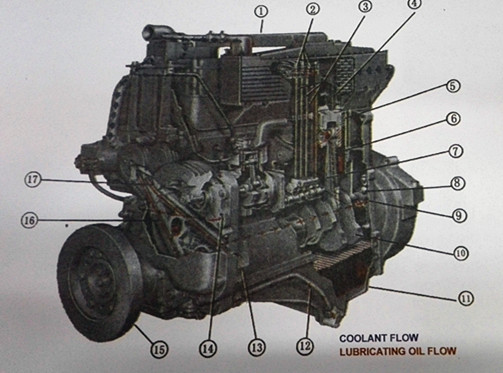
1. INTAKE AIR CROSSOVER
2. ROCKER LEVERS
3. PUSH TUBES
4. INJECTOR
5. PISTON
6. CONNECTION ROD
7. CAM FOLLOWERS
8. CRANKSHAFT OIL SEAL
9. MAIN OIL PASSAGE
10. CRANKSHAFT
11. OIL PAN
12. OIL SUPPLY TUBE
13. LUBRICATING OIL PUMP
14. OIL TO ASSISTANT DRIVING
15. VIBRATION DAMPER
16. OIL FROM COOLER
17. OIL TO COOLER
Cooling System
Water is circulated by a centrifugal water pump mounted either in or on the front of the engine belt driven from the accessory drive or crankshaft.
Water circulates around wet-type cylinder liners, through the cylinder heads and around the injector sleeves. The injector sleeves, in which the injectors are mounted, are designed for fast dissipation of heat. The engine has a thermostat or thermostats to control the engine operating temperature. The engine coolant is cooled in a heat exchanger or keel coder. Sea water is circulated through heat exchanger by the raw waler pump, mounted on front of engine, and discharge through connections on the heat exchanger.
The Fleetguard Water Filter is standard on Chong Qing-Cummins Engines. The filter by-passes a small amount of coolant from the system via a filtering and treating element which must be replaced periodically.
NTA Aftercooled Engine
Water flows from the heat exchanger into the cavity of the water pump, where the water flow splits. One portion circulates to the cylinder block water header around wet type cylinder liners, through the cylinder head and around the injector sleeves, upwards to the water manifold, to the thermostat housing. At the rear of the block water header, the water is directed to the after-cooler. Water flows forward through the aftercooler to the water crossover to the thermostat housing. The second portion of water flows from the cavity of the water pump housing through the oil cooler and tubing to the rear of the water manifold forward to the thermostat housing, to control engine temperature.
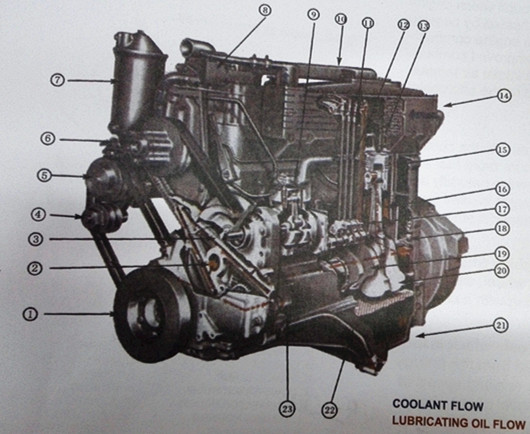
1. VIBRATION DAMPER
2. OIL FROM COOLER
3. OIL TO COOLER
4. IDLER PULLEY
5. WATER PUMP
6. FAN HUB
7. OIL FILTER
8. THERMOSTAT
9. AIR COMPRESSOR
10. INTAKE AIR CROSSOVER
11. ROCKER LEVERS
12. PUSH TUBES
13. INJECTOR
14. AFTERCOLLER
15. PISTON
16. CONNECTING ROD
17. CAM FOLLWERS
18. CRANKSHAFT OIL SEAL
19. MAIN OIL PASSAGE
20. CRANKSHAFT
21. OIL PAN
22. OIL SUPPLY TUBE
23. LUBRICATING OIL PUMP
Cooling Systems of Cummins generator set
1) Air inlet should be set on the ends or both sides of generators, with the area 2.2 times greater than the tank area.
2) The air outlet area should be 1.5 times of water tank area, and the shutters and wind wall should be installed at the air outlets.
3) Flexible duct flanges are used to connect to the water tank, so as to absorb displacement and vibration of the units and prevent the spread of noise.
4) Hot air must be vented to the outside of the chamber through the air duct, and the duct area should be smoothly transitted from small to large values. If there are curves in the air ducts, the guide plate must be installed in order to reduce the pressure loss.
5) When the environment temperature is higher than the design temperature, we should consider using it by reducing the power.
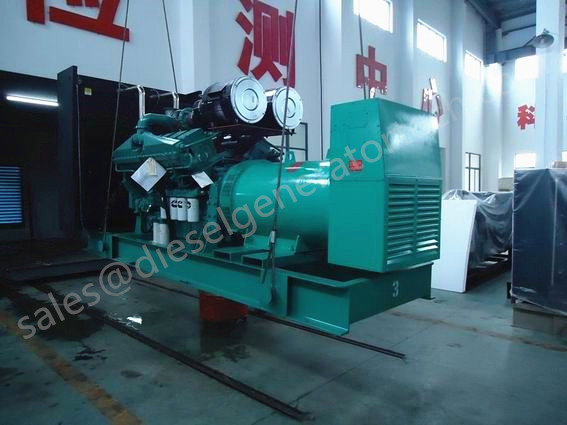
Air System
The diesel engine requires hundreds of gallons of air for every gallon of fuel that it burns. For the engine to operate efficiently, it must breathe freely; intake and exhaust systems must not be restricted.
The intake air should always be touted through an air cleaner. The cleaner may be mounted on the engine or equipment and may be either oil path, paper element or composite type depending upon engine application. Air is routed from the air cleaner directly to the intake air manifold.
NTA Aftercooler
An aftercooler (or intercooler as it is sometimes called) is a device in the engine intake system designed to reduce intake air temperature and preheat intake air temperature.
The aftercooler consists of a housing, used as a portion of the engine intake air manifold, with an internal core. The core is made of tubes through which engine coolant circulates. Air is cooled or heated by passing over the core prior to going into the engine combustion chambers. Therefore, improved combustion results from better control of the intake air temperature cooling or warming as applied by the aftercooler.
Turbocharger
The turbocharger forces additional air into the combustion chambers so the engine can burn more fuel and develop more horsepower than if it were naturally aspirated. In some cases the turbocharger is used for the engine to retain efficiency (balanced fuel to air ratio) at altitudes above sea level.
The turbocharger consists of a turbine wheel and a centrifugal blower, or compressor wheel, separately encased but mounted on and rotating with a common shaft.
The power to drive the turbine wheel – which in turn drives the compressor – is obtained from the energy of the engine exhaust gases. The rotating speed of the turbine changes as the energy level of gas changes; therefore, the engine is supplied with enough air to burn fuel for its load requirements. The turbocharger is lubricated and cooled by engine lubricating oil.
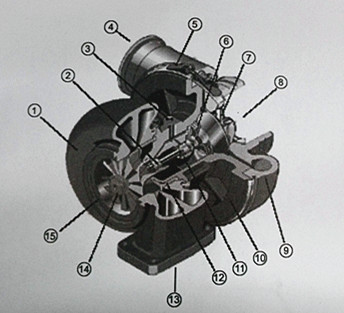
1. TURBINE HOUSING
2. BEARINGS
3. OIL INLET
4. AIR TO ENGINE
5. "V" BAND CLAMP
6. "O" RING ENGINE
7. COMPRESSOR WHEEL
8. AIR INLET
9. COMPRESSOR HOUSING
10/11. BEARING HOUSING
12. HEAT SHIELT
13. EXHAUST INLET
14. TURBINE WHEEL AND SHAFT
15. EXHAUST OUTLET
Note: Our company can provide Dongfeng Cummins (24KW to 220KW) and Chong Qing-Cummins generator (200KW to 1320KW). No matter it is the design, production or testing of Cummins generator, it is full complied with national standards GB/T2820-97. The excitation system of the generator enables the quick recovery of frequency fluctuation in any instantaneous loading. low power design of the genset minimizes the waveform distortion under nonlinear loads, and brings a good ability of starting motor.
Copyright © Guangxi Dingbo Generator Set Manufacturing Co., Ltd. All Rights Reserved | Sitemap
Update cookies preferences